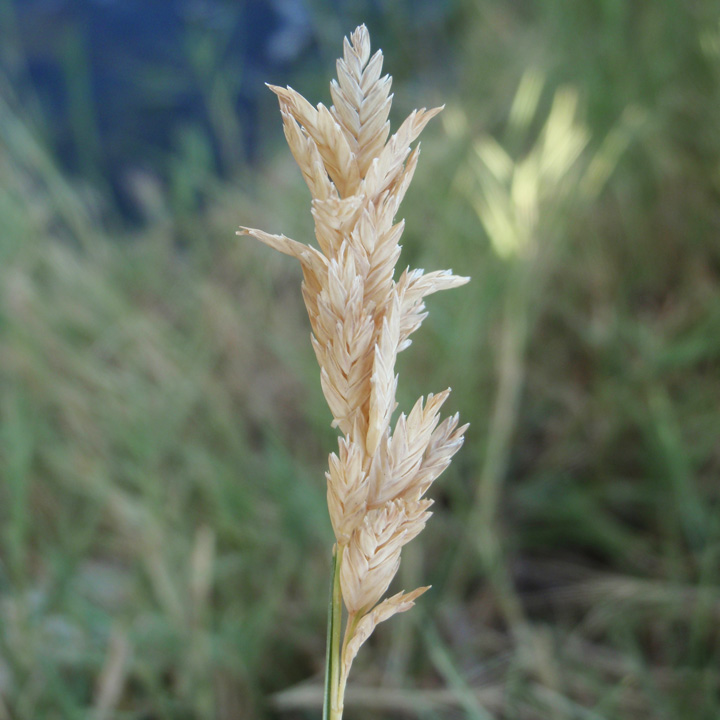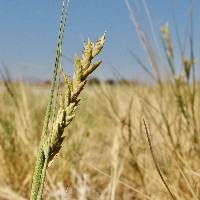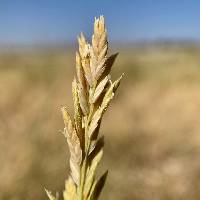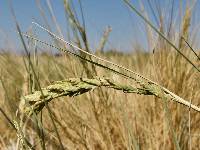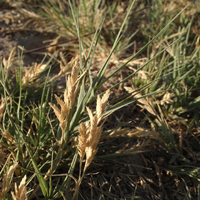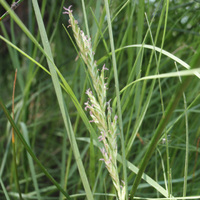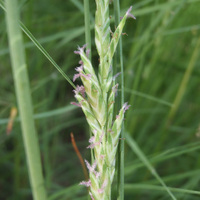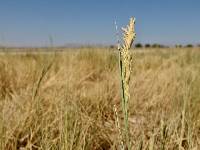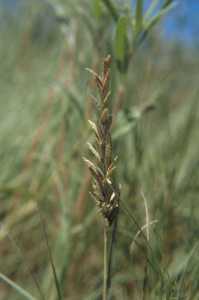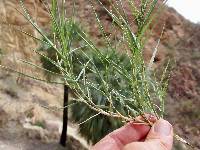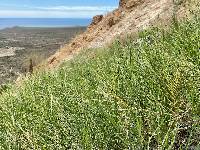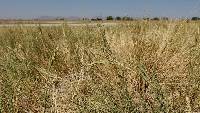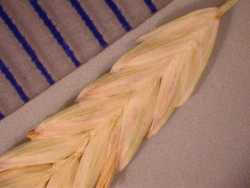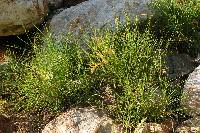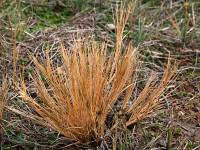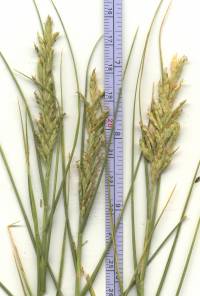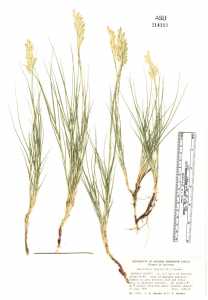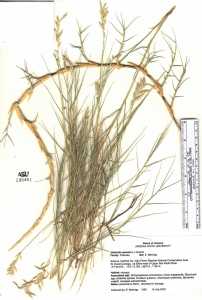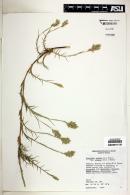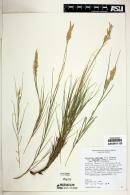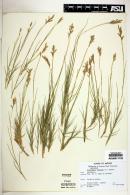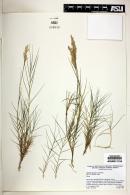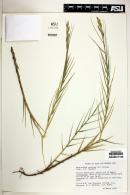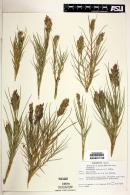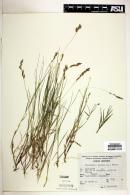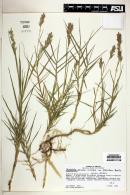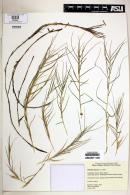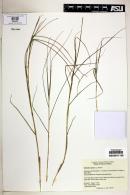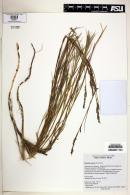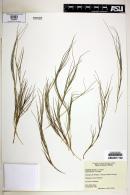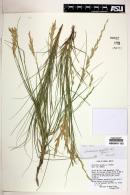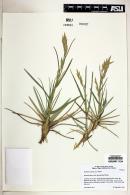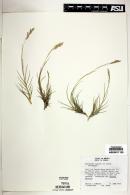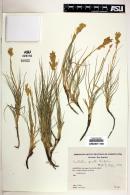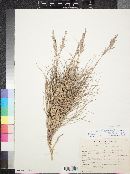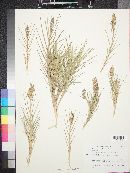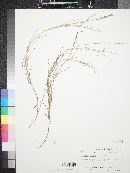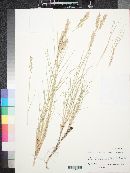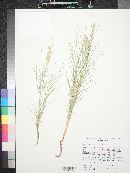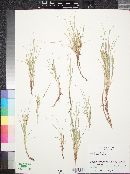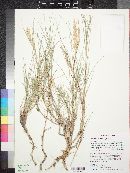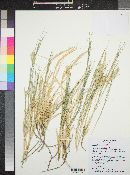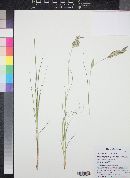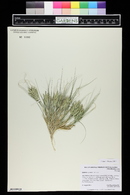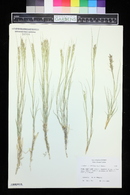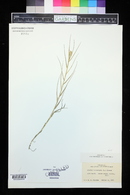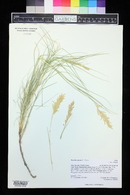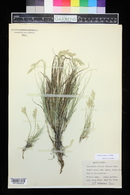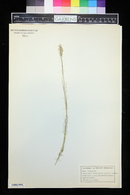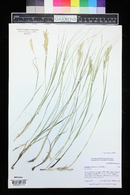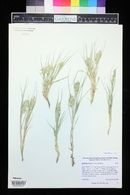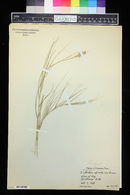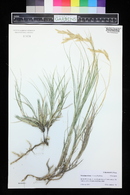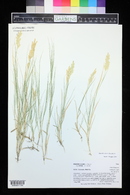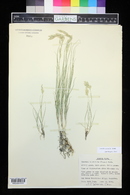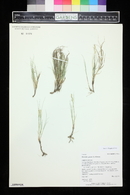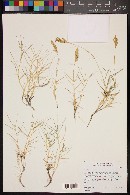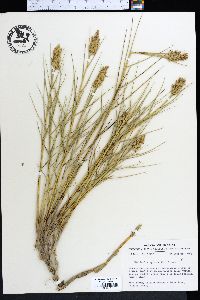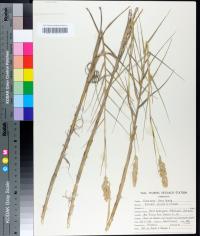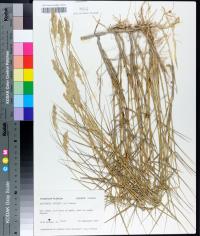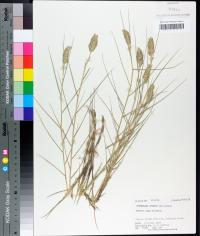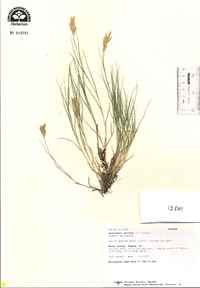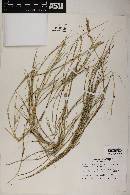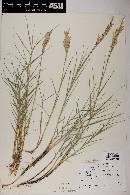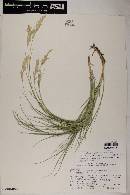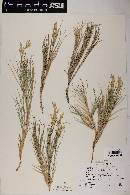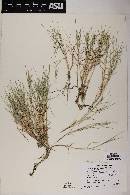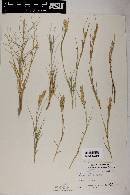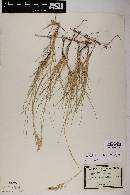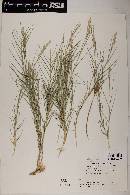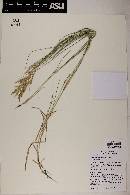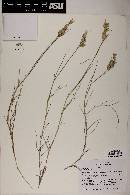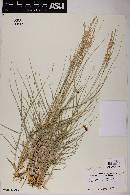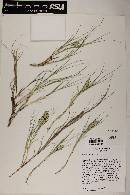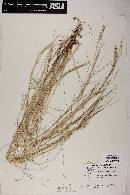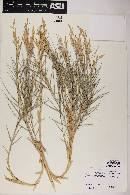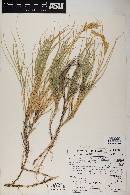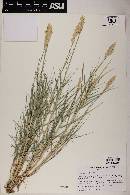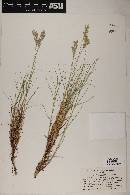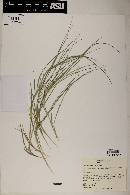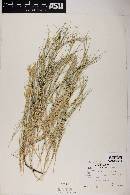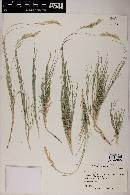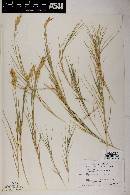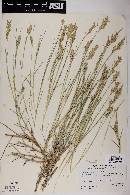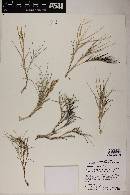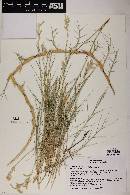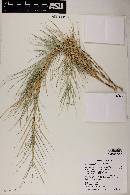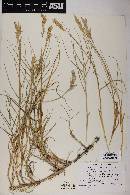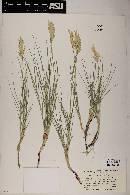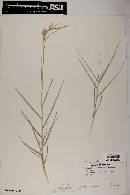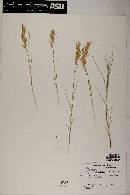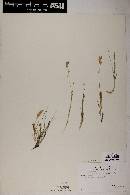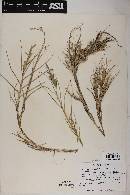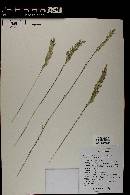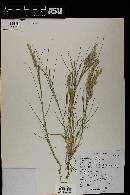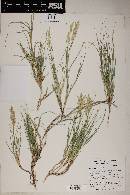Distichlis spicata
|
|
|
|
Family: Poaceae
Coastal Salt Grass, more...saltgrass, desert saltgrass, inland saltgrass, marsh spikegrass, seashore saltgrass (es: zacate espinudo, huizapole, zacate salado)
[Agropyron peruvianum (Lam.) Roem. & Schult., moreBrachypodium peruvianum Roem. & Schult. ex Kunth, Brizopyrum americanum (L.) Link, Brizopyrum ovatum Nees ex Steud., Brizopyrum prostratum var. erectum E. Fourn., Brizopyrum prostratum var. humile E. Fourn., Brizopyrum spicatum , Brizopyrum thalassicum (Kunth) Nees, Distichlis bajaensis H.L.Bell, Distichlis maritima , Distichlis nodosa Raf., Distichlis spicata subsp. stricta (Torr.) Thorne, Distichlis spicata var. borealis (J. Presl) Beetle, Distichlis spicata var. divaricata Beetle, Distichlis spicata var. mexicana , Distichlis spicata var. nana Beetle, Distichlis spicata var. stolonifera Beetle, Distichlis spicata var. stricta (Torr.) Scribn., Distichlis stricta (Torr.) Rydb., Distichlis stricta var. dentata (Rydb.) C.L. Hitchc., Festuca spicata Nutt., Festuca triticea Lam. ex Kunth, Festuca triticoides Lam., Megastachya thalassica (Kunth) Roem. & Schult., Poa michauxii Kunth, Poa thalassica Kunth, Triticum peruvianum Lam., Uniola multiflora , Uniola spicata L., Uniola stricta , Uniola thalassica (Kunth) Trin.] |
1. Inflorescences composed of a single spikelet; leaf blades 0.5-1.5 cm long, stiff ..... D. littoralis Plants rhizomatous and sometimes stoloniferous. Culms 10-60 cm, usually erect, sometimes decumbent or prostrate. Blades of upper leaves 1-8(20) cm, rigid and divaricate to lax and ascending, usually equaling or exceeding the pistillate panicles, varying with respect to the staminate panicles. Pistillate panicles 1-7 cm, often congested, with 2-20 spikelets. Pistillate spikelets 5-20 mm long, 4-7 mm wide, with 5-20 florets; lower glumes 2-3 mm; upper glumes 3-4 mm; lemmas 3.5-6 mm; paleas with serrate keels. Caryopses 2-5 mm, tapered or truncate. Staminate panicles and spikelets similar to the pistillate panicles and spikelets, but the lemmas somewhat thinner in texture and the paleas not bowed-out. Anthers 3-4 mm. 2n = 40. Distichlis spicata grows in saline soils of the Western Hemisphere and Australia. Numerous infraspecific taxa have been recognized in the past, but none appears to be justified. Recent North American accounts of Distichlis have usually recognized plants from maritime coasts as distinct from those growing inland, supposedly having more congested inflorescences, but the range of variation is similar in the two habitats. López Soto et al. (2009) examined the leaf anatomy of six species and 11 varieties of Distichlis. They found that D. australis and D. palmeri differed from all other species and that D. humilis, D. spicata, and D. scoparia were anatomically similar but distinguishable. They found no characters or character combinations that supported recognition of infraspecific taxa within D. spicata. Harrington et al. (2009), on the other hand, found that inland plants, which Rydberg called D. stricta, differed from coastal plants in molecularly, cytogenetically, and in their phenology. On that basis, it seems that treatment of the inland plants as D. spicata subsp. stricta (Torr.) Thorne is warranted. The reason for no treating them as species is pragmatic, the lack of morphological characters for distinguishing them. Plants with long, wiry stolons. Culms 8-15 cm, clustered, erect, with numerous short, leafy, lateral branches. Leaves clustered on distant to closely-spaced, short, lateral shoots; sheaths 4-6 mm, rounded, smooth, shiny, glabrous or puberulent at the base; ligules thickly membranous ciliate rims; blades 0.5-1.5 cm long, 1-2(3) mm wide, stiff, subulate, uniformly many-veined. Inflorescences terminal, composed of a single glabrous spikelet, this enclosed, and almost concealed, by the uppermost leaf sheaths. Pistillate spikelets subterete, with 3-5 florets, distal florets rudimentary; disarticulation tardy, below the lowest floret; glumes absent; lemmas coriaceous, glabrous, 9-veined, acute; paleas coriaceous, keels prominently winged, wings overlapping and enclosing the caryopses. Staminate spikelets similar to the pistillate spikelets, but smaller and the glumes and lemmas thinner. x = 10. Name from the Greek monos, single, anthos, flower, and chloë, grass, alluding to the solitary spikelets. 2n = 40. Distichlis littoralis grows in moist, sandy, saline soils along the coast of southern California and the southeastern United States, northeastern Mexico, and the Caribbean islands. It was previously placed in Monanthochloë but Bell and Columbus (2008) demonstrated that Monanthochloë is nested within Distichlis. Perennial rhizome-bearing herb, often with runners 10 cm - 0.67 m tall Leaves: distinctly two-ranked, with the lower leaves reduced to scale-like sheaths and the upper sheaths overlapping. The membranous ligules are toothed and less than 1 mm long, while the stiff upper blades are 1 - 20 cm long and hairless. Inflorescence: terminal, branched (panicle), 1 - 7 cm long, often crowded with two to twenty spikelets. Flowers: either male or female, borne on separate plants (dioecious). Fruit: a brown, hairless caryopsis. Culm: 10 cm - 0.6 m long, usually erect, sometimes decumbent to prostrate, hairless. Spikelets: 5 - 20 mm long, 4 - 7 mm wide, laterally compressed, with five to twenty florets. Glumes: unequal, with lower glumes 2 - 3 mm long and upper glumes 3 - 4 mm long. Female floret: with a 3.5 - 6 mm long lemma that lacks an awn and a palea with two toothed longitudinal ridges. Male floret: similar to the female floret but with a thinner lemma, a narrower palea, and three anthers 3 - 4 mm long. Similar species: No information at this time. Flowering: June Habitat and ecology: Introduced from the western United States, this species is occasional in salty waste areas such as railroad yards and industrial areas. Occurence in the Chicago region: non-native Etymology: Distichlis comes from the Greek word distichos, meaning two-ranked. Spicata means spiked. Author: The Morton Arboretum FNA 2003, Gould 1980, Cronquist et al. 1977 Common Name: saltgrass Duration: Perennial Nativity: Native Lifeform: Graminoid General: Rhizomatous to sometimes stoloniferous perennial grass with stems 16-60 cm, usually erect, sometimes decumbent or prostrate at base. Vegetative: Blades of upper leaves 1-8 cm, rigid and divaricate to lax and ascending, equaling or exceeding pistillate panicle, usually involute or folded. Inflorescence: Plants are dioecious, with male and female flowers on separate plants. Pistillate panicle 1-7 cm, often contracted and congested with 2-20 spikelets; spikelets 5-20 mm long, 4-7 mm wide with 5-20 florets; lower glumes 2-3 mm, upper glumes 3-4 mm; lemmas 3-6 mm, paleas with serrate and winged keels; caryopses 2-5 mm, tapered or truncate; staminate panicles and spikelets similar to pistillate ones, but lemmas with thinner texture and pales not bowed out. Ecology: Found on saline soils below 6,000 ft (1829 m); flowers June-September. Distribution: Native to most of N. Amer. except some of the midwest, nw CAN, AL; south through MEX to S. Amer.; also in Australia. Notes: Often forms dense mats and groundcover where it occurs due to its stolons, rhizomes, and densely tufted stems; often grows in moist saline or low-lying areas; distinguished by the flattened spikelets with many florets, and the distichous blades (blades have a 2-ranked arrangement, which forms a plane as they alternately come off either side of the stem). Ethnobotany: Taken as a laxative, for pimples, as a heart medicine, for gonorrhea, cooked into a gum to treat colds, for loss of appetite, as a condiment, and the leaves and stems were used for food. Also used as a grain source by various tribes. Etymology: Distichlis comes from Greek distichos for two-ranked, a reference to the leaf arrangement, while spicata means spicate, referring to the inflorescence. Synonyms: Distichlis spicata var. borealis, D. spicata var. divaricata, D. spicata var. nana, D. spicata var. stolonifera, D. spicata var. stricta, D. spicata subsp. stricta, D. stricta, D. stricta var. dentata, Uniola spicata Editor: SBuckley 2010, FSCoburn 2015, AHazelton 2015 Colonial from hard, white rhizomes with stiff scales; stems 1.5-4 dm, with numerous rigid, involute lf-blades 5-10 cm, the lvs often pilose at the collar; infl congested, short, to 8 cm; lemmas ovate or lance-ovate, about equaling the palea, this with 2 winged keels, the wings ciliolate and/or irregularly serrate; 2n=40. Two vars. Gleason, Henry A. & Cronquist, Arthur J. 1991. Manual of vascular plants of northeastern United States and adjacent Canada. lxxv + 910 pp. ©The New York Botanical Garden. All rights reserved. Used by permission. Infl less dense, the pedicels more exposed; principal spikelets 12-20 mm, avg more numer- ously fld, the pistillate with typically 7 fls, the staminate with 10-18 fls; first glume 2.8-5.1 mm, the second 3.6-6.6 mm; lemmas 4.4-7.5 mm; keels of the pistillate paleas more broadly winged; collar more conspicuously pilose. Saline soil or alkaline situations in the interior; w. U.S. and adj. Can., e. to Sask., Minn., and Mo. (D. stricta) Gleason, Henry A. & Cronquist, Arthur J. 1991. Manual of vascular plants of northeastern United States and adjacent Canada. lxxv + 910 pp. ©The New York Botanical Garden. All rights reserved. Used by permission. |
|
|
|

